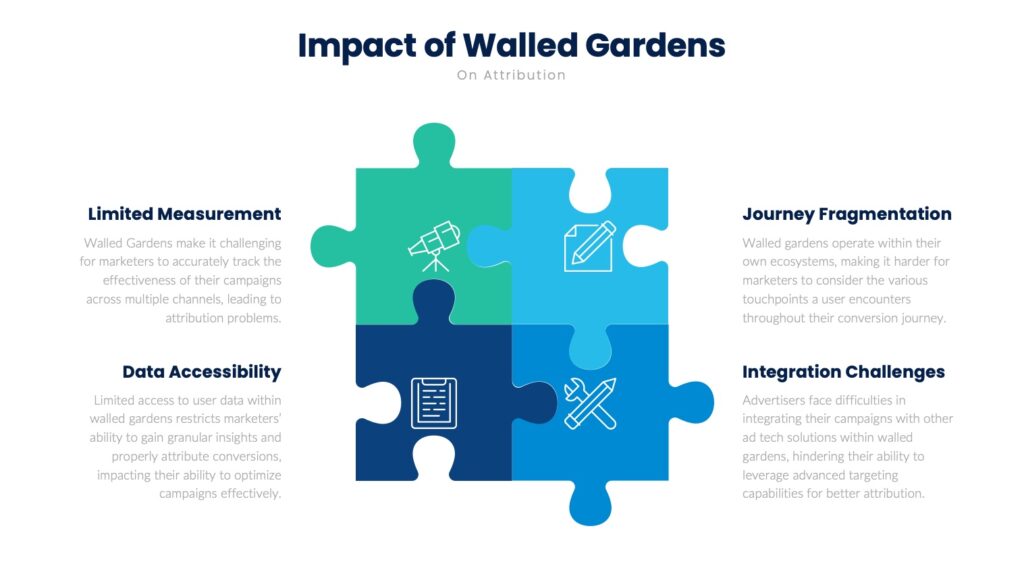Walled gardens have become a common and often frustrating reality for many marketers. These advertising platforms — specifically the big three tech giants: Facebook, Amazon, and Google — provide vast audiences and sophisticated targeting capabilities but limit transparency and access to user data. As a marketer, have you ever stopped to consider the impact of walled gardens on your own data? How much control do you have over the data that you collect, and how transparent is your access to it?
With many companies investing significant resources in digital advertising, the impact of walled gardens on attribution and transparency is becoming increasingly significant. As you navigate this complex landscape, it’s important to consider the limitations and drawbacks of walled gardens, as well as the potential benefits they can offer.
What marketers and publishers need to know about walled gardens in advertising?
A walled garden is a closed ecosystem where the technology provider has significant control over the data and where ad publishers are required to conduct their activities within the confines of the platform.
- Companies that operate within walled gardens are subject to specific rules and limitations set by the platform owners, often resulting in higher ad spend and ad revenue for the companies themselves. According to a study by eMarketer, The Big Three collectively controlled over 60% of digital ad spend in the United States in 2021.
- Walled gardens function within the larger context of ad tech and programmatic advertising, often resulting in a more streamlined and integrated ecosystem. However, this integration can also limit access to data and transparency for marketers seeking to understand their ad performance.
- The history of walled garden ecosystems is brief but impactful, with Facebook and Google’s dominance leading to increased in-house advertising and a shift away from traditional advertising methods. As noted by AdAge, this shift has caused many publishers to rely on The Big Three as their primary sources of revenue, creating a dependency on these platforms.
- The term “walled gardens” was first coined in the telecommunication industry, where companies like AT&T created closed ecosystems for their services. Time Warner, which owned media properties like HBO, CNN, and Warner Bros., was later acquired by AT&T leading to concerns over media consolidation and the potential impact on the advertising industry.
Overall, while walled gardens provide benefits to the owners and an integrated advertising ecosystem, it limits transparency and flexibility. Understanding the limitations and benefits of walled gardens is crucial for marketers seeking to navigate the digital advertising landscape.
The pros and cons of walled gardens like Google, Facebook and Amazon
The benefits of walled gardens include their ability to offer highly targeted and personalized advertising opportunities. This is made possible by the massive amounts of data collected by the platforms, which can provide valuable insights into user behavior and preferences. However, walled gardens also come with significant drawbacks. One of the most significant is the limited access to user data, which is owned and controlled by the platform owners. This can make it challenging for you to accurately attribute conversions and optimize their campaigns.
In addition, those platforms often come with high costs and limited transparency, which can make it difficult for marketers to accurately track their ROI and determine the true value of their ad spend. Another potential drawback of walled gardens is their impact on competition in the advertising industry. With dominant players like Facebook and Google controlling large portions of the ad market, it can be challenging for smaller companies to compete effectively.
| Pros | Cons | |
| Facebook Ads | Data includes interests, behaviors, and location data. Advertisers can use this data to create highly targeted advertising campaigns and reach specific audiences on the platform. | Changes to its data policies in recent years mean advertisers may not have access to the same level of user data as they did in the past. Additionally, Facebook’s targeting capabilities are based on user behavior and engagement on the platform, which may not always translate to offline behaviors or interests. |
| Google Ads | Data includes search history, and browsing behavior. Additionally, advertisers can reach specific audiences across Google’s network of platforms, including Google Search, YouTube, and the Google Display Network. | Ad fraud and click fraud are ongoing challenges for advertisers on Google, with some estimates suggesting that up to 20% of ad clicks may be fraudulent. This can lead to wasted ad spend and limited ROI for advertisers. |
| Amazon Ads | Data includes purchase history, and browsing behavior on Amazon.com. The acquisition of Whole Foods Market has provided data about health-conscious and environmentally conscious consumers. | Lack of transparency, limited access to user data, attribution challenges, limited ad format options |
Overall, while these platforms offer many benefits, they also present significant limitations and drawbacks. As the advertising industry continues to evolve, it’s crucial for marketers to weigh the pros and cons of walled gardens carefully and consider alternative analytics platforms that prioritize data ownership and transparency.
Walled gardens impact on attribution: A give and take

Walled gardens have a significant impact on data that advertisers can leverage, making it challenging to accurately track conversions and optimize their campaigns.
- Because advertisers must rely on each platform’s proprietary ad manager, they may struggle to measure the effectiveness of campaigns across multiple channels. This can lead to discrepancies in attribution and make it difficult to understand the true impact of different advertising efforts on conversion rates and revenue.
- With each platform operating within its own ecosystem, advertisers may face challenges integrating their campaigns with other ad tech solutions or leveraging advanced targeting capabilities. This can limit the ability of advertisers to build advanced attribution models that take into account the various touchpoints that a user encounters on their journey to conversion.
Despite these challenges, there are several strategies that advertisers can use to navigate the impact of walled gardens on ad tech and attribution. One approach is to focus on developing first-party data strategies and investing in data management platforms that allow for more granular audience segmentation and tracking. Additionally, advertisers can leverage advanced attribution models that take into account the various touchpoints that a user encounters on their journey to conversion.
Another important strategy for advertisers is to prioritize transparency and measurement. This means setting clear goals for campaigns, tracking performance metrics closely, and holding the platforms accountable for providing accurate and comprehensive data.
The future of walled gardens in ad tech

The future of walled gardens remains uncertain. On one hand, these platforms offer advertisers and marketers access to vast audiences and sophisticated targeting capabilities. On the other hand, their closed nature limits transparency and access to user data, making it difficult to accurately track the performance of their campaigns.
To mitigate the limitations of walled gardens, many advertising and marketing professionals are turning to header bidding and other workarounds to access more data and make more informed decisions about their campaigns. Additionally, some walled gardens have opened up access to their platforms, offering more data and insights into user behavior. Amazon has been taking steps to open up its platform and provide advertisers with more data and insights, indicating a potential shift away from closed ecosystems in the future.
Despite these developments, many marketers are looking to alternative advertising models that prioritize transparency and data ownership. Open-source ad tech platforms, for example, offer advertisers the ability to access audience insights without the limitations of a closed ecosystem.
The future of walled gardens in advertising is likely to be shaped by ongoing debates over data ownership, transparency, and competition in the ad tech industry. As advertising and marketing experts continue to seek out audience insights, it’s important to consider alternative advertising models that prioritize transparency and data ownership.
At Wizaly, we understand the challenges that marketers face in navigating the complexities of the digital advertising landscape. Our customer journey attribution software platform is designed to provide marketers with the tools they need to accurately track the performance of their campaigns and make data-driven decisions that drive growth and revenue. By leveraging advanced data analytics and machine learning technology, Wizaly offers marketers unparalleled visibility into the customer journey, helping them optimize their campaigns and achieve their business goals.
As the advertising industry continues to evolve, understanding the role and limitations of walled gardens is crucial. To learn more about how Wizaly can help you optimize your ad efforts and overcome the challenges of walled garden attribution, visit us at Wizaly.com today.



